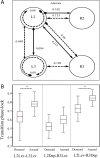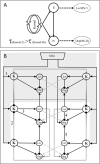Endogenous rhythm and pattern-generating circuit interactions in cockroach motor centres
- PMID: 27422902
- PMCID: PMC5051644
- DOI: 10.1242/bio.018705
Endogenous rhythm and pattern-generating circuit interactions in cockroach motor centres
Abstract
Cockroaches are rapid and stable runners whose gaits emerge from the intricate, and not fully resolved, interplay between endogenous oscillatory pattern-generating networks and sensory feedback that shapes their rhythmic output. Here we studied the endogenous motor output of a brainless, deafferented preparation. We monitored the pilocarpine-induced rhythmic activity of levator and depressor motor neurons in the mesothoracic and metathoracic segments in order to reveal the oscillatory networks' architecture and interactions. Data analyses included phase relations, latencies between and overlaps of rhythmic bursts, spike frequencies, and the dependence of these parameters on cycle frequency. We found that, overall, ipsilateral connections are stronger than contralateral ones. Our findings revealed asymmetries in connectivity among the different ganglia, in which meta-to-mesothoracic ascending coupling is stronger than meso-to-metathoracic descending coupling. Within-ganglion coupling between the metathoracic hemiganglia is stronger than that in the mesothoracic ganglion. We also report differences in the role and mode of operation of homologue network units (manifested by levator and depressor nerve activity). Many observed characteristics are similar to those exhibited by intact animals, suggesting a dominant role for feedforward control in cockroach locomotion. Based on these data we posit a connectivity scheme among components of the locomotion pattern generating system.
Keywords: Central pattern generator; Cockroach; Connectivity model; Extracellular-recording; Locomotion control.
© 2016. Published by The Company of Biologists Ltd.
Conflict of interest statement
The authors declare no competing or financial interests.
Figures







Similar articles
-
From Motor-Output to Connectivity: An In-Depth Study of in-vitro Rhythmic Patterns in the Cockroach Periplaneta americana.Front Insect Sci. 2021 May 20;1:655933. doi: 10.3389/finsc.2021.655933. eCollection 2021. Front Insect Sci. 2021. PMID: 38468881 Free PMC article.
-
Rhythmic patterns evoked in locust leg motor neurons by the muscarinic agonist pilocarpine.J Neurophysiol. 1993 May;69(5):1583-95. doi: 10.1152/jn.1993.69.5.1583. J Neurophysiol. 1993. PMID: 8389831
-
Intersegmental coordination of cockroach locomotion: adaptive control of centrally coupled pattern generator circuits.Front Neural Circuits. 2011 Jan 20;4:125. doi: 10.3389/fncir.2010.00125. eCollection 2011. Front Neural Circuits. 2011. PMID: 21369365 Free PMC article.
-
Reorganization of the human central nervous system.Gen Physiol Biophys. 2000 Oct;19 Suppl 1:11-240. Gen Physiol Biophys. 2000. PMID: 11252267 Review.
-
On the Role of the Head Ganglia in Posture and Walking in Insects.Front Physiol. 2020 Feb 21;11:135. doi: 10.3389/fphys.2020.00135. eCollection 2020. Front Physiol. 2020. PMID: 32153430 Free PMC article. Review.
Cited by
-
Rigidity and Flexibility: The Central Basis of Inter-Leg Coordination in the Locust.Front Neural Circuits. 2017 Jan 11;10:112. doi: 10.3389/fncir.2016.00112. eCollection 2016. Front Neural Circuits. 2017. PMID: 28123358 Free PMC article.
-
Existence of a Long-Range Caudo-Rostral Sensory Influence in Terrestrial Locomotion.J Neurosci. 2022 Jun 15;42(24):4841-4851. doi: 10.1523/JNEUROSCI.2290-20.2022. Epub 2022 May 11. J Neurosci. 2022. PMID: 35545434 Free PMC article.
-
Unravelling intra- and intersegmental neuronal connectivity between central pattern generating networks in a multi-legged locomotor system.PLoS One. 2019 Aug 6;14(8):e0220767. doi: 10.1371/journal.pone.0220767. eCollection 2019. PLoS One. 2019. PMID: 31386699 Free PMC article.
-
Intra- and intersegmental influences among central pattern generating networks in the walking system of the stick insect.J Neurophysiol. 2017 Oct 1;118(4):2296-2310. doi: 10.1152/jn.00321.2017. Epub 2017 Jul 19. J Neurophysiol. 2017. PMID: 28724783 Free PMC article.
-
Information-based centralization of locomotion in animals and robots.Nat Commun. 2019 Aug 13;10(1):3655. doi: 10.1038/s41467-019-11613-y. Nat Commun. 2019. PMID: 31409794 Free PMC article.
References
-
- Ayali A., Borgmann A., Büschges A., Couzin-Fuchs E., Daun-Gruhn S. and Holmes P. (2015b). The comparative investigation of the stick insect and cockroach models in the study of insect locomotion. Curr. Opin. Insect Sci. 12, 1-10. 10.1016/j.cois.2015.07.004 - DOI
-
- Bässler U. and Wegner U. (1983). Motor output of the denervated thoracic ventral nerve cord in the stick insect Carausius morosus. J. Exp. Biol. 105, 127-145.
-
- Becht G., Hoyle G. and Usherwood P. N. R. (1960). Neuromuscular transmission in the coxal muscles of the cockroach. J. Insect Physiol. 4, 191-201. 10.1016/0022-1910(60)90026-3 - DOI
LinkOut - more resources
Full Text Sources
Other Literature Sources

